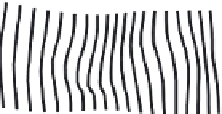Biology Reference
In-Depth Information
0.08
0.06
0.04
0.02
A
0
B
0.02
0.04
0.06
0.1
0.05
0
0.05
0.1
PC1
Pygopristis denticulata
Serrasalmus altuvei
S. elongatus
S. gouldingi
S. manueli
S. spilopleura
Pygocentrus cariba
P. nattereri
P. piraya
(A)
(B)
FIGURE 13.5
Analyzing direction in which species differ from
P. denticulata
in juvenile shape, to determine
whether species with overlapping scores on PC1, but different scores on PC2, are similar with respect to features
varying along PC1. (A) The direction of difference from
P. denticulata
to
S. manueli
; (B) the direction of difference
from
P. denticulata
to
S. gouldingi
and
S. elongatus.
Based upon the similarities between the two vectors (Figures 13.5A, 13.5B), what all three
taxa share is their shallow body. There also may be a second similarity not described by
either PC
a shortening of the mid-body relative to the head and posterior body. We
could include that in the description of the character, but we would exclude the propor-
tions of the caudal peduncle from that character description because
S. manueli
differs
from the other two species in that clearly, the character is not equivalent to a PC.
The reason for not treating PC2 as a character in its own right is the same as the one
we used to rule out treating individual PWs as characters.
S. manueli
,
S. altuvei
and also
S. spilopleura
have high scores on this one, which primarily describes a displacement of the
opercle landmark towards the pectoral fin and a shortening of the caudal peduncle rela-
tive to the anal fin. However,
S. manueli
and
S. altuvei
differ along PC1 and are not similar
in caudal peduncle proportions; they also differ along PC3 (Figure 13.6). Differences along
PC3, as well as those along PC1, might belie the inference of morphological similarity














































































































































































































































































































































































































































































































































































































































































































